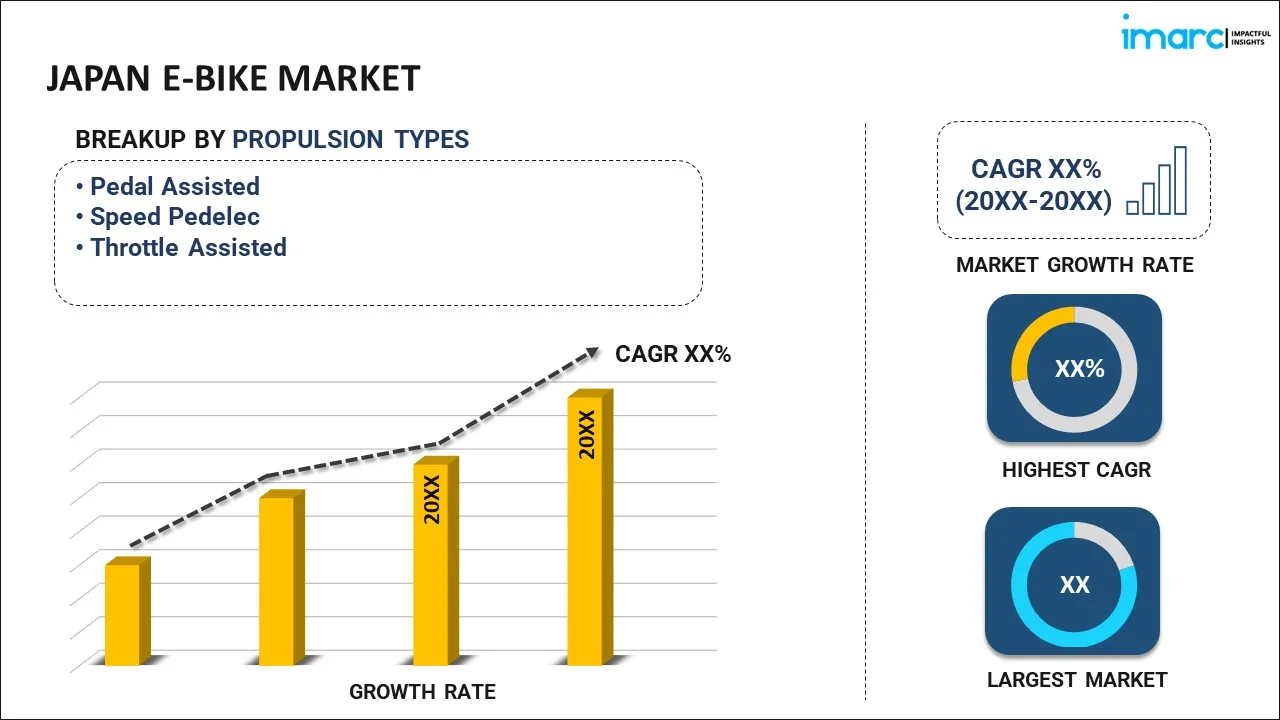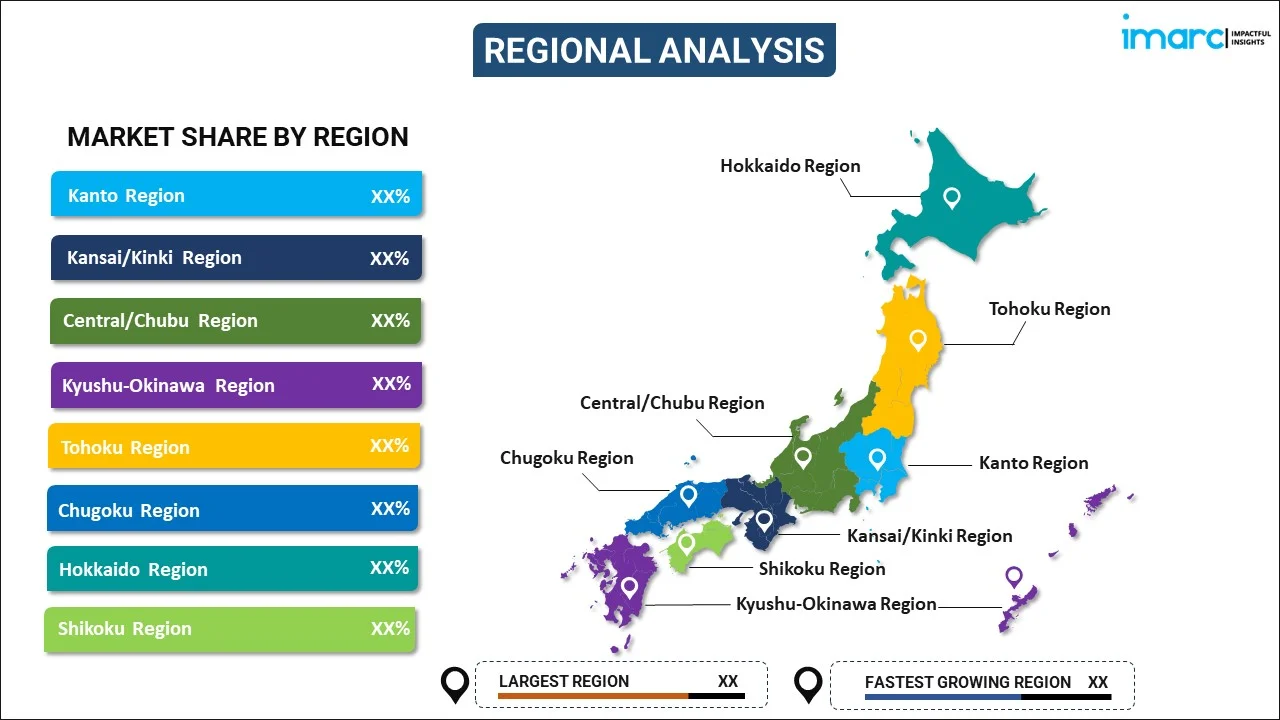
Japan E-Bike Market Report by Propulsion Type (Pedal Assisted, Speed Pedelec, Throttle Assisted), Application Type (Cargo/Utility, City/Urban, Trekking), Battery Type (Lead Acid Battery, Lithium-ion Battery, and Others), and Region 2025-2033
Market Overview:
Japan e-bike market size reached USD 2,965.0 Million in 2024. Looking forward, IMARC Group expects the market to reach USD 4,654.0 Million by 2033, exhibiting a growth rate (CAGR) of 5.1% during 2025-2033. The rising consumer environmental concerns and numerous technological advancements in the production techniques of e-bikes are primarily driving the market growth.
|
Report Attribute
|
Key Statistics
|
|---|---|
|
Base Year
|
2024 |
|
Forecast Years
|
2025-2033
|
|
Historical Years
|
2019-2024
|
| Market Size in 2024 | USD 2,965.0 Million |
| Market Forecast in 2033 | USD 4,654.0 Million |
| Market Growth Rate (2025-2033) | 5.1% |
An electric bicycle, or e-bike, represents a multifunctional transportation method, integrating the characteristics of conventional bicycles with the advantages of an electric motor. It comes fitted with a battery that can be charged, and it provides different levels of assistance with pedaling to the cyclist, thus significantly simplifying actions like ascending hills or traveling extended distances. Numerous e-bikes also feature a throttle, enabling riders to progress without the need to pedal, resembling a motorcycle. They are crafted to be environmentally friendly, with no emissions of greenhouse gases, positioning them as a sustainable commuting option. The convenience, economical price, and user-friendliness of e-bikes have earned them substantial popularity. They accommodate a broad spectrum of users, from those desiring a more effortless, less strenuous cycling experience, to individuals considering them as a viable substitute for automobiles for short journeys. Progressions in battery technologies mean contemporary e-bikes provide greater distance coverage and reduced charging durations, amplifying their attractiveness for recreational and urban purposes.
Japan E-Bike Market Trends:
Increasing Environmental Concerns and Sustainability Goals
The growing awareness regarding pollution and climate change is prompting demand for eco-friendly transportation options, with e-bikes serving as a low-emission alternative which is expected to drive the market growth across Japan. As a result, bicycle sharing services have expanded rapidly across Japan, with hundreds of local governments either fully implementing or trialing the service. As of 2022, 305 local governments had fully adopted these services, while 61 were in trial phases. Another 397 are considering adoption. Fees generally range from 100 to 200 yen for 30 minutes. The service's popularity has been driven by advances in technology and decarbonization efforts, leading to a rise in bike-sharing stations from 828 in 2014 to over 15,000 in 2022. Private operators, such as Docomo Bikeshare, Hello Cycling, and Luup, have contributed to the expansion, with services varying by location. These initiatives are pivotal in promoting the widespread adoption of e-bikes, thereby contributing to the market growth.
Rising Urban Traffic and Space Constraints
E-bikes provide a practical solution in crowded cities, allowing riders to avoid traffic, navigate narrow streets, and reduce commute times. As per a report from the Ministry of Land, Infrastructure, Transport, and Tourism, rail congestion rates in Japan’s three major metropolitan areas, Tokyo, Osaka, and Nagoya, continued to increase in 2023. The average rate of congestion during peak morning hours for the metropolitan areas, respectively, was 136% in Tokyo (up 13 points year on year), 115% in Osaka (up 6 points), and 123% in Nagoya (up 5 points). E-bikes can travel at higher speeds than traditional bicycles, making them a time-efficient choice for commuting, which encourages more people to choose biking over driving. This is expected to boost the overall Japan e-bike market share significantly. By providing an alternative to cars for short to medium-distance trips, e-bikes decrease the number of vehicles on the road, contributing to less traffic congestion.
Significant Technological Advancements
Improvements in battery life, motor efficiency, and lightweight materials make e-bikes more user-friendly, extending their range and performance, which drives consumer interest and subsequent product adoption. In line with this, a novel gear-shifting system that taps artificial intelligence to assist cyclists is scheduled to be launched by the Japanese bicycle parts maker Shimano by 2025, as announced by the company in September 2024. Similarly, in October 2023, Yamaha launched two electric bicycles ahead of the Japan Mobility Show and the Booster, which is an electric moped with futuristic scooter-like styling. Such product launches are reflective of the advanced technologies that manufacturers are increasingly integrating in their product variants, which is resulting in the launch of better and more efficiently functional models of e-bikes.
Japan E-Bike Market Segmentation:
IMARC Group provides an analysis of the key trends in each segment of the market, along with forecasts at the country level for 2025-2033. Our report has categorized the market based on propulsion type, application type, and battery type.
Propulsion Type Insights:

- Pedal Assisted
- Speed Pedelec
- Throttle Assisted
The report has provided a detailed breakup and analysis of the market based on the propulsion type. This includes pedal assisted, speed pedelec, and throttle assisted.
Application Type Insights:
- Cargo/Utility
- City/Urban
- Trekking
A detailed breakup and analysis of the market based on the application type have also been provided in the report. This includes cargo/utility, city/urban, and trekking.
Battery Type Insights:
- Lead Acid Battery
- Lithium-ion Battery
- Others
The report has provided a detailed breakup and analysis of the market based on the battery type. This includes lead acid battery, lithium-ion battery, and others.
Regional Insights:

- Kanto Region
- Kansai/Kinki Region
- Central/ Chubu Region
- Kyushu-Okinawa Region
- Tohoku Region
- Chugoku Region
- Hokkaido Region
- Shikoku Region
The report has also provided a comprehensive analysis of all the major regional markets, which include Kanto Region, Kansai/Kinki Region, Central/ Chubu Region, Kyushu-Okinawa Region, Tohoku Region, Chugoku Region, Hokkaido Region, and Shikoku Region.
Competitive Landscape:
The market research report has also provided a comprehensive analysis of the competitive landscape in the market. Competitive analysis such as market structure, key player positioning, top winning strategies, competitive dashboard, and company evaluation quadrant has been covered in the report. Also, detailed profiles of all major companies have been provided.
Japan E-Bike Market News:
- In November 2023, Honda announced the launch of the Honda e-MTB Concept, its first electric bicycle, by drawing a cue from almost all other major automotive manufacturers. The Honda e-MTB Concept retains a reasonably realistic design while having a more downhill-oriented appearance.
- In June 2024, Yamaha launched a new E-Ride Base in Yokohama, a dedicated showroom that will allow visitors to experience Yamaha's electric-assist bicycles, offering free 30-minute rentals and guided tours of the city. The facility features a 180° theater screen and a lounge serving green tea from Shizuoka Prefecture, enhancing the visitor experience.
- In September 2024, JATCO Ltd and HODAKA CORPORATION unveiled a prototype electric-assist bicycle equipped with a JATCO drive unit. This prototype model is intended for mass production and is scheduled to be launched in the market by 2025. Prior to the unveiling, JATCO and HODAKA signed a Memorandum of Understanding (MOU) for the mass production of the electric-assist bicycles equipped with the JATCO drive unit.
Japan E-Bike Market Report Coverage:
| Report Features | Details |
|---|---|
| Base Year of the Analysis | 2024 |
| Historical Period | 2019-2024 |
| Forecast Period | 2025-2033 |
| Units | Million USD |
| Scope of the Report | Exploration of Historical and Forecast Trends, Industry Catalysts and Challenges, Segment-Wise Historical and Predictive Market Assessment:
|
| Propulsion Types Covered | Pedal Assisted, Speed Pedelec, Throttle Assisted |
| Application Types Covered | Cargo/Utility, City/Urban, Trekking |
| Battery Types Covered | Lead Acid Battery, Lithium-ion Battery, Others |
| Regions Covered | Kanto Region, Kansai/Kinki Region, Central/ Chubu Region, Kyushu-Okinawa Region, Tohoku Region, Chugoku Region, Hokkaido Region, Shikoku Region |
| Customization Scope | 10% Free Customization |
| Post-Sale Analyst Support | 10-12 Weeks |
| Delivery Format | PDF and Excel through Email (We can also provide the editable version of the report in PPT/Word format on special request) |
Key Questions Answered in This Report:
- How has the Japan e-bike market performed so far and how will it perform in the coming years?
- What has been the impact of COVID-19 on the Japan e-bike market?
- What is the breakup of the Japan e-bike market on the basis of propulsion type?
- What is the breakup of the Japan e-bike market on the basis of application type?
- What is the breakup of the Japan e-bike market on the basis of battery type?
- What are the various stages in the value chain of the Japan e-bike market?
- What are the key driving factors and challenges in the Japan e-bike?
- What is the structure of the Japan e-bike market and who are the key players?
- What is the degree of competition in the Japan e-bike market?
Key Benefits for Stakeholders:
- IMARC’s industry report offers a comprehensive quantitative analysis of various market segments, historical and current market trends, market forecasts, and dynamics of the Japan e-bike market from 2019-2033.
- The research report provides the latest information on the market drivers, challenges, and opportunities in the Japan e-bike market.
- Porter's five forces analysis assist stakeholders in assessing the impact of new entrants, competitive rivalry, supplier power, buyer power, and the threat of substitution. It helps stakeholders to analyze the level of competition within the Japan e-bike industry and its attractiveness.
- Competitive landscape allows stakeholders to understand their competitive environment and provides an insight into the current positions of key players in the market.
Need more help?
- Speak to our experienced analysts for insights on the current market scenarios.
- Include additional segments and countries to customize the report as per your requirement.
- Gain an unparalleled competitive advantage in your domain by understanding how to utilize the report and positively impacting your operations and revenue.
- For further assistance, please connect with our analysts.
 Request Customization
Request Customization
 Speak to an Analyst
Speak to an Analyst
 Request Brochure
Request Brochure
 Inquire Before Buying
Inquire Before Buying




.webp)




.webp)












